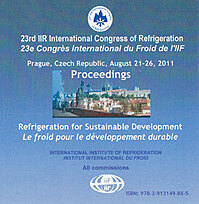
Document IIF
Problèmes de qualité de l'air intérieur dans les immeubles passifs.
Indoor air quality problems in passive buildings.
Numéro : pap. ID: 356
Auteurs : MÜLLER J., SKRZYNIOWSKA D.
Résumé
There are various contaminants in habitable buildings (from people, animals, equipment, lighting, etc.). In standards and regulations, one can find minimum airflow required for ventilation according to indoor air quality category. Poland is not the only country where natural ventilation is one of the most popular types of ventilation systems. Natural ventilation does not always work properly, does not supply required airflow. Therefore, there are symptoms of Sick Building Syndrome, excessive amount of carbon dioxide and water vapor and a risk of carbon monoxide presence. The idea of passive buildings is to minimize energy loss to the environment therefore new designed passive buildings have 100%: sealed windows, doors, walls. Passive buildings need mechanical ventilation systems but owners do not always install such system because of some disadvantages (noise, space for ductwork, air handling unit, intake and exhaust opening, investment cost etc.). The paper presents short characteristics of air pollution in average building, simple calculation of energy required for ventilation and some real problems with mechanical ventilation systems.
Documents disponibles
Format PDF
Pages : 7 p.
Disponible
Prix public
20 €
Prix membre*
Gratuit
* meilleur tarif applicable selon le type d'adhésion (voir le détail des avantages des adhésions individuelles et collectives)
Détails
- Titre original : Indoor air quality problems in passive buildings.
- Identifiant de la fiche : 30002724
- Langues : Anglais
- Source : Proceedings of the 23rd IIR International Congress of Refrigeration: Prague, Czech Republic, August 21-26, 2011. Overarching theme: Refrigeration for Sustainable Development.
- Date d'édition : 21/08/2011
Liens
- Voir les traductions : Problemas de calidad del aire interior en los edificios pasivos.
Voir d'autres communications du même compte rendu (569)
Voir le compte rendu de la conférence
Indexation
-
Natural ventilation and automation with manual ...
- Auteurs : PAASSEN A. H. C. van, LUTE P. J.
- Date : 17/02/1992
- Langues : Anglais
Voir la fiche
-
Long term monitoring of residential heat recove...
- Auteurs : CREMERS B.
- Date : 16/06/2013
- Langues : Anglais
- Source : Clima 2013. 11th REHVA World Congress and 8th International Conference on Indoor Air Quality, Ventilation and Energy Conservation in Buildings.
- Formats : PDF
Voir la fiche
-
Towards a better indoor air quality through a c...
- Auteurs : MARE R., GOGLIANO SOBRINHO O., CHAVES COELHO LEITE B., et al.
- Date : 16/06/2013
- Langues : Anglais
- Source : Clima 2013. 11th REHVA World Congress and 8th International Conference on Indoor Air Quality, Ventilation and Energy Conservation in Buildings.
- Formats : PDF
Voir la fiche
-
Indoor air quality for Latvian schools accordin...
- Auteurs : PLAVENIEKS G.
- Date : 16/06/2013
- Langues : Anglais
- Source : Clima 2013. 11th REHVA World Congress and 8th International Conference on Indoor Air Quality, Ventilation and Energy Conservation in Buildings.
- Formats : PDF
Voir la fiche
-
Human response to ductless personalized ventila...
- Auteurs : DALEWSKI M., BIVOLAROVA M., FILLON M., et al.
- Date : 16/06/2013
- Langues : Anglais
- Source : Clima 2013. 11th REHVA World Congress and 8th International Conference on Indoor Air Quality, Ventilation and Energy Conservation in Buildings.
- Formats : PDF
Voir la fiche
